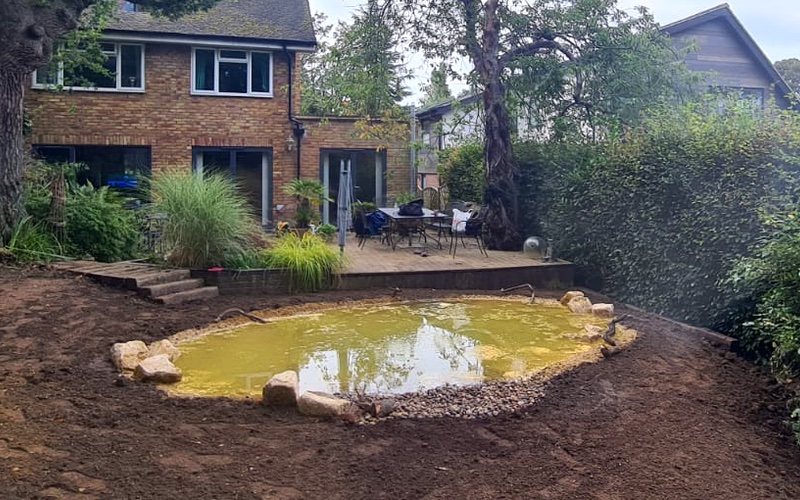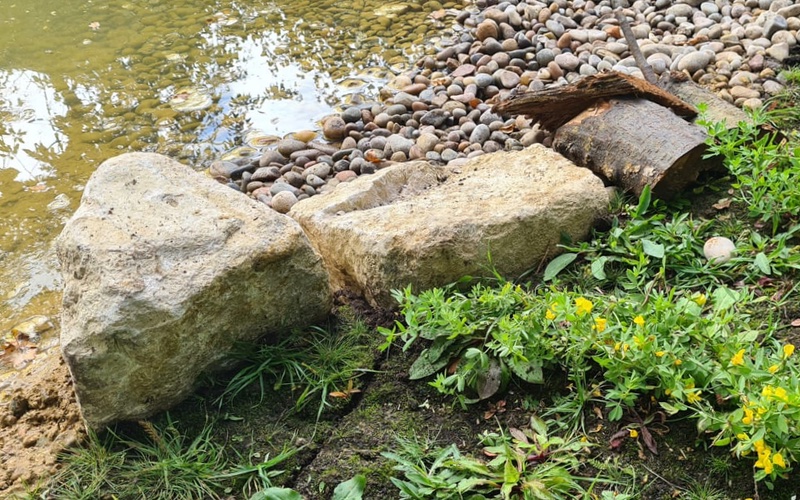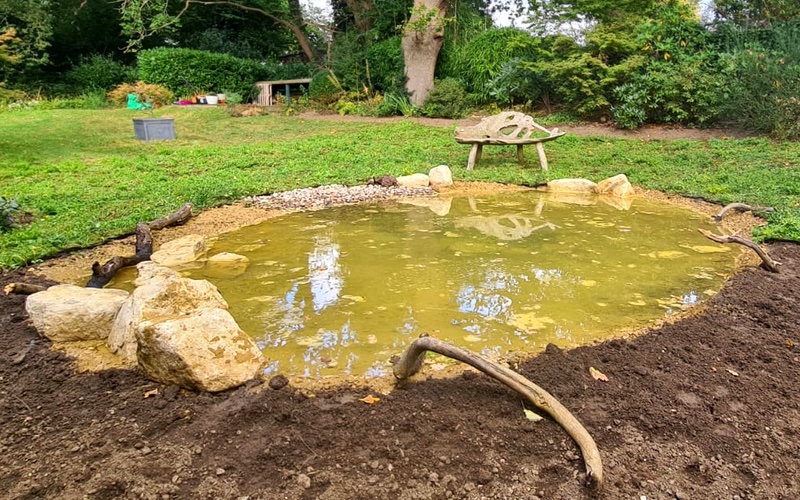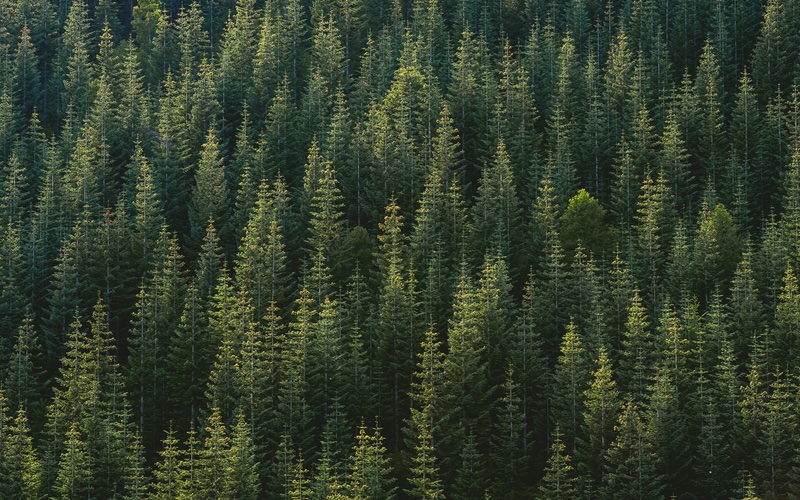THE LANDSCAPING SOLUTIONS BLOG
Welcome to our Blog. Inspiration, updates and industry trends from the team at Landscaping Solutions.
WILDLIFE PONDS
If you’re motivated to make a difference to biodiversity or simply wish to while away the day watching wildlife then you need a pond in your garden.

A professional garden or landscape designer will know where best to place a pond in your garden.
Here’s how to make it happen;
Take time to select an experienced professional to work with. A garden or landscape designer with a passion for creating naturalistic spaces will know how to attract wildlife to the garden and have an instinctive understanding of where best place to place the pond. This might be a natural dip in the lay of the land or an open area away from overhanging trees, preferably in a sunny spot as most insect and plant life thrives in warm, shallow and sunlit conditions. However, we ensure there’s at least two to three feet of depth at some point so hibernating frogs have a place to overwinter. Pond sides should gently slope to the depths to provide trouble-free wildlife access so we always create a shallow ‘beach’ area at one end.

A shallow beach area at one end of the pond provides trouble-free access for wildlife.
A clever designer will plan to save and reuse as much excavated material as possible during the build process. Fertile topsoil can be used to create borders or banks elsewhere in the garden and less fertile sub-soil can be used as growing media in the pond.
Then it’s time to get creative with the planting. Our planting schemes utilise oxygenators such as Hornwort, Water Crowfoot or Spiked Milfoil along with some floating species such as Frogbit, Fringed Water Lilly and Water Soldier. A smattering of emergent species and marginal plants such Amphibious Bistort, Brooklime, Water Avens, Purple Loosestrife, Marsh Marigold, Water Mint and Hard and Soft Rush can be planted directly in to the soil layer in and around the pond.

Boulders and deadwood are great for providing a hiding place for amphibians.
To make the pond more naturalistic we add boulders, stumps, deadwood, bark and branches to provide hiding places for amphibians and perches for birds and dragonflies. Now it’s time to sit back to see what comes in. It won’t be long before beetles, backswimmers, water boatmen and pond-skaters start to arrive. Snails won’t be far behind followed by frogs, toads and newts once the vegetation establishes. Within a year or so you’ll have a fully functioning ecosystem helping to redress the balance of habitat loss in the wider countryside and a constant source of enjoyment and learning.
For more information on how Landscaping Solutions can transform your garden, contact Ben West on 0208 241 2402 or email info@landscapingsolutionsltd.co.uk
BEWARE GREENWASHING
There are better ways to improve a company’s carbon footprint than carbon offsetting and mass tree planting schemes, says Landscaping Solutions MD Ben West.

Large companies will often offset their carbon footprint through mass tree planting schemes.
It’s wonderful to see once marginalised environmental issues becoming mainstream concerns, but we must ensure that action in these areas is both genuine and focused in the right direction. We must beware of ‘greenwashing’. Unscrupulous marketing departments have latched on to the fact that environment and sustainability issues are making headlines and are exploiting consumer naivety, a lack of consensus and toothless regulatory frameworks to increase sales and enter new markets. This seeds mistrust, confusion and apathy in the consumer. Research has shown that consumers can become indifferent or indeed harbour negative feelings towards green marketing, legitimate or otherwise, following sustained exposure to greenwashing.
Companies can declare sustainable credentials through carbon offsetting. What is carbon offsetting? In the simplest terms it is the balancing out of an individual’s or company’s carbon emissions by their funding an activity that involves the sequestering of carbon. A plane passenger travelling from London to Amsterdam can ‘offset’ a proportion of the carbon produced by that flight against the carbon sequestered by a tree planting scheme they have funded. Offsetting as part of a long-term plan for culture change is to be admired and encouraged but all too often these schemes are reminiscent of the absent father sending money to the kids whilst he’s away on ‘business’ with the secretary. Offsetting schemes assuage guilt without addressing the underlying issues - which is probably why fossil fuel companies like them so much.

Some airlines use tree planting schemes so they can offer passengers the opportunity to offset a proportion of the carbon produced by their flight.
Can we really buy our way out of the climate crisis? Carbon is best left where it is - in the ground. It’s not enough to carry on business as usual whilst throwing money at offsetting schemes which are at best well-intentioned but ineffective and at worst cynical and damaging. A better policy is to protect existing natural systems whilst rewilding wherever possible. The best way to plant trees is to allow them to regenerate naturally. Jays and squirrels plant trees throughout the autumn for free. This is much more sustainable than armies of trees planters driving to remote sites and much more likely to succeed.
Take a look at the images of HS2’s failed attempts to greenwash the impact of their atrocities in the Chilterns; fields full of plastic tubes containing dead and dying saplings. Remember that the thorn is the mother of the oak; a tangle of thorny scrub (possibly the most undervalued of all our native habitats), consisting of hawthorn, dog rose, blackthorn and bramble is a far more effective nurse to the species that will eventually become climax woodland: ash, oak and beech.
In any case we shouldn’t get too fixated on tree planting as a panacea for all our climate and biodiversity ills. We need a diverse mosaic of habitats to contribute to carbon fixing and biodiversity gains. Woodland is well down the pecking order when it comes to holding carbon in the landscape. Seagrass meadows, mangroves and salt marshes are all examples of habitat that are ahead of woodlands in the carbon fixing stakes. Top of the list are peatlands: tundra, bogs, fens, moorland, meres and mires. These are the very habitats that some elements of our industry are keen to see relocated and releasing carbon in pots, planters and borders up and down the country. We damage these habitats, and unlock carbon in the process, when we disturb them. Disturbance includes planting trees on them, as well as on heathland, ancient woodland and a host of other fragile and threatened habitats. This has happened throughout the twentieth century in this country and may continue should we blindly pursue ill-conceived carbon offsetting schemes or political promises geared to gaining the popular vote at the ballot box.